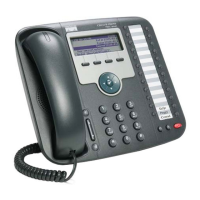4-14
Cisco Unified IP Phone 7931G Administration Guide for Cisco Unified Communications Manager 8.0 (SCCP and SIP)
OL-20798-01
Chapter 4 Configuring Settings on the Cisco Unified IP Phone
Network Configuration Menu
IPv6 DNS Server 1
IPv6 DNS Server 2
Primary DNS server (DNS Server 1) and optional
backup DNS servers (DNS Server 2) used by the
phone.
If your configuration includes both DNSv6 and
DNSv4 servers, the phone will look for its DNS
server in the following order:
1. IPv6 DNS Server 1
2. IPv6 DNS Server 2
3. DNS Server 1-5 for IPv4 (respectively)
1. Unlock network configuration options.
2. Set the DHCPv6 option to No.
3. Scroll to the appropriate DNS Server option,
press the Edit softkey, and then enter a new
DNS server IP address.
4. Press the Validate softkey.
5. Repeat Steps 3 and 4 as needed to assign the
backup DNS server.
6. Press the Save softkey.
DHCPv6 Address
Released
Releases the IPv6 address that the phone has
acquired from the DHCPv6 server or by stateless
address autoconfiguration.
Note This field can be edited only when the
DHCPv6 option is enabled.
1. Unlock network configuration options.
2. Scroll to the DHCPv6 Address Released
option and press the Ye s softkey to release the
IP address assigned by DHCP, or press the No
softkey if you do not want to release this
IP address.
3. Press the Save softkey.
IPv6 Alternate
TFTP
Indicates if the phone is using the IPv6 Alternate
TFTP server.
1. Unlock network configuration options.
2. Scroll to the IPv6 Alternate TFTP option and
press the Ye s softkey if the phone should use
an alternative TFTP server.
3. Press the Save softkey.
Table 4-4 IPv6 Configuration Menu Options (continued)
Option Description To Change

